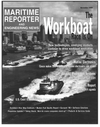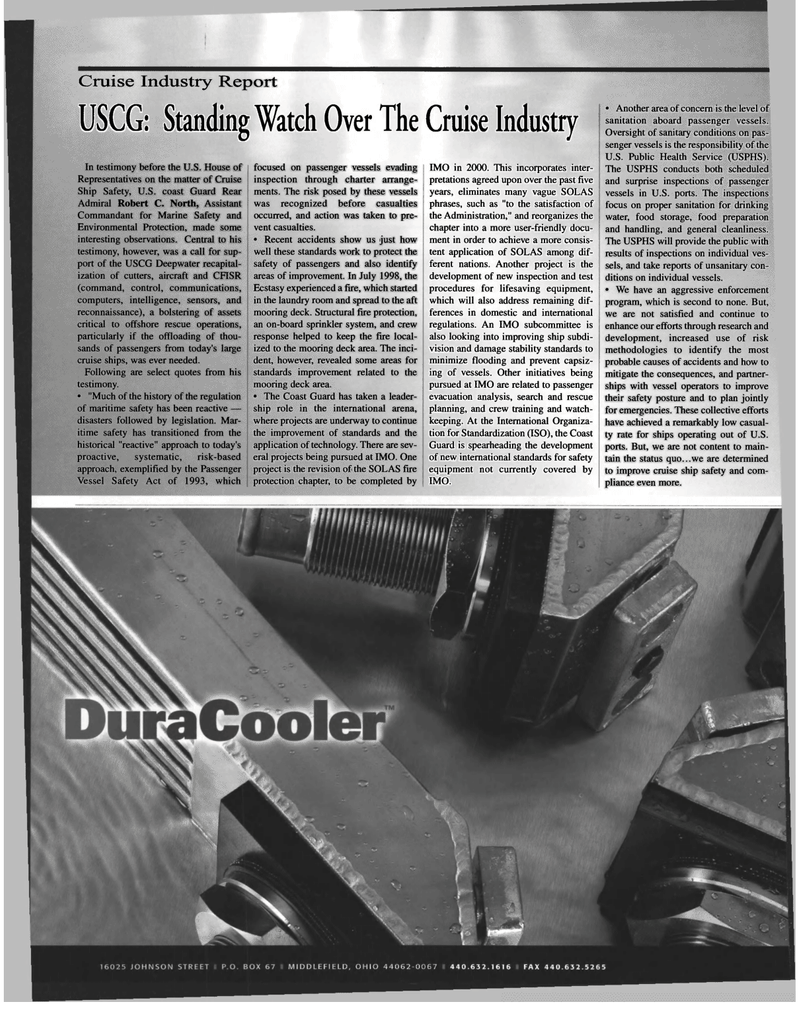
Page 30: of Maritime Reporter Magazine (November 1999)
Read this page in Pdf, Flash or Html5 edition of November 1999 Maritime Reporter Magazine
Cruise Industry Report USCG: Standing Watch Over The Cruise Industry In testimony before the U.S. House of Representatives on the matter of Cruise Ship Safety, U.S. coast Guard Rear Admiral Robert C. North, Assistant Commandant for Marine Safety and Environmental Protection, made some interesting observations. Central to his testimony, however, was a call for sup-port of the USCG Deepwater recapital-ization of cutters, aircraft and CFISR (command, control, communications, computers, intelligence, sensors, and reconnaissance), a bolstering of assets critical to offshore rescue operations, particularly if the offloading of thou-sands of passengers from today's large cruise ships, was ever needed. Following are select quotes from his testimony. ? "Much of the history of the regulation of maritime safety has been reactive ? disasters followed by legislation. Mar-itime safety has transitioned from the historical "reactive" approach to today's proactive, systematic, risk-based approach, exemplified by the Passenger Vessel Safety Act of 1993, which focused on passenger vessels evading inspection through charter arrange-ments. The risk posed by these vessels was recognized before casualties occurred, and action was taken to pre-vent casualties. ? Recent accidents show us just how well these standards work to protect the safety of passengers and also identify areas of improvement. In July 1998, the Ecstasy experienced a fire, which started in the laundry room and spread to the aft mooring deck. Structural fire protection, an on-board sprinkler system, and crew response helped to keep the fire local-ized to the mooring deck area. The inci-dent, however, revealed some areas for standards improvement related to the mooring deck area. ? The Coast Guard has taken a leader-ship role in the international arena, where projects are underway to continue the improvement of standards and the application of technology. There are sev-eral projects being pursued at IMO. One project is the revision of the SOLAS fire protection chapter, to be completed by IMO in 2000. This incorporates inter-pretations agreed upon over the past five years, eliminates many vague SOLAS phrases, such as "to the satisfaction of the Administration," and reorganizes the chapter into a more user-friendly docu-ment in order to achieve a more consis-tent application of SOLAS among dif-ferent nations. Another project is the development of new inspection and test procedures for lifesaving equipment, which will also address remaining dif-ferences in domestic and international regulations. An IMO subcommittee is also looking into improving ship subdi-vision and damage stability standards to minimize flooding and prevent capsiz-ing of vessels. Other initiatives being pursued at IMO are related to passenger evacuation analysis, search and rescue planning, and crew training and watch-keeping. At the International Organiza-tion for Standardization (ISO), the Coast Guard is spearheading the development of new international standards for safety equipment not currently covered by IMO. ? Another area of concern is the level of sanitation aboard passenger vessels. Oversight of sanitary conditions on pas-senger vessels is the responsibility of the U.S. Public Health Service (USPHS). The USPHS conducts both scheduled and surprise inspections of passenger vessels in U.S. ports. The inspections focus on proper sanitation for drinking water, food storage, food preparation and handling, and general cleanliness. The USPHS will provide the public with results of inspections on individual ves-sels, and take reports of unsanitary con-ditions on individual vessels. ? We have an aggressive enforcement program, which is second to none. But, we are not satisfied and continue to enhance our efforts through research and development, increased use of risk methodologies to identify the most probable causes of accidents and how to mitigate the consequences, and partner-ships with vessel operators to improve their safety posture and to plan jointly for emergencies. These collective efforts have achieved a remarkably low casual-ty rate for ships operating out of U.S. ports. But, we are not content to main-tain the status quo...we are determined to improve cruise ship safety and com-pliance even more.

 29
29

 31
31
